Marc Weidenbaum's Blog, page 473
January 8, 2013
This is a test post.
This is a test post, the third in a series being published. It’ll be deleted momentarily.
Dub and Its Online Echo
The temporal proximity of live music performances to their release online as audio documents, whether streaming or downloadable, creates a peculiar shift in the relation between audience and performer. For a long time, such a document was just that: a historic record of an event. But when just a few days pass between the live event and the dispersed recording, it feels more like the record is itself part of the event, that it’s less a recording than a distant echo, that it’s less an accounting of the sound and more of an emanation of the sound. To bask in that echo, to listen to it so shortly after the fact of the initial event, is still a form of participation. That image of a digital-media echo is especially appropriate for this set by wndfrm. A dub- and techno-infused performance he did on January 3 in Vancouver, British Columbia, it’s a prime example of grid music, a slight moiré of gently shifting rhythmic figures, barely a handful of beats heard in a slow, relaxed sequence of changes. There is a period, around 45 minutes into the 54-minute performance, when a tiny clank, like the chirp of some small bird, adds a side beat to the underlying lattice. It’s a moment of techno Jenga, as one more element is added to the existing structure. To wndfrm’s credit, the structure holds.
Live recording originally posted for free download at soundcloud.com/wndfrm. More on/from wndfrm, who is Tim Westcott of Portland, Oregon, at twitter.com/wndfrm.
Here, for reference, are the two tracks that wndfrm cites as source material for his set:
Robert Hood’s “Detroit: One Circle”:
Autechre’s “Goz Quarter”:
January 7, 2013
Deeply Fuzzy Tonal Manipulation (MP3)
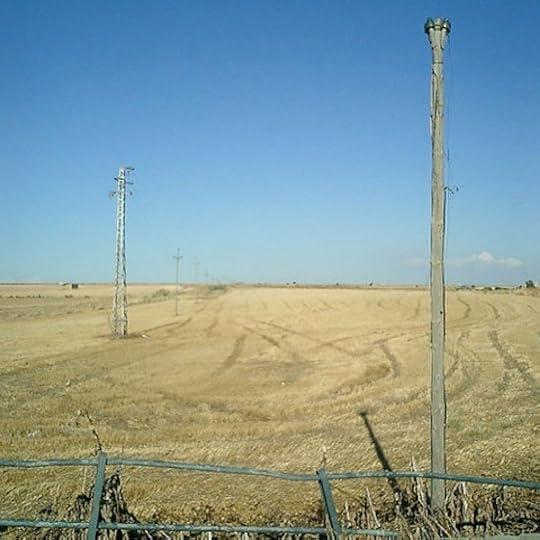
Almost everything that the New Hampshire–based musician Dave Seidel releases was recorded live, and “The Limits of Control” is no exception. And as always, the work is credited not to Seidel directly but to his Mysterybear moniker. It’s a nearly 14-minute drone of deeply fuzzy tonal manipulation. More than many tracks, it sounds like its waveform looks: like a thick singular object twisted this way and that. (Waveforms are always on display for tracks posted, such as this one, on SoundCloud.com.) One particularly fascinating thing about the track is how it has as its foundation exactly the sort of buzzing, droning sound that would be annoying to a musician under most circumstances. It would signal a troubled wire or a broken piece of equipment. Here, though, it isn’t a source of frustration but of bliss.
Track originally posted for free download at soundcloud.com/mysterybear. More on Seidel/Mysterybear at mysterybear.net. The above image was associated with the track by Seidel; it is “Nowhere in Spain” by swizzled and was borrowed from Flickr under a Creative Commons license. It’s hard not to imagine that the track’s underlying buzz in some way correlates with those towers — are they for communication, or are they electrical, or both? — that he posted to accompany the music.
January 6, 2013
New Year, After the Break (MP3)
It’s arguable that the first week of the new year is best spent as yet another week in an ongoing sequence of weeks. Better that than an attempt to plan for a year of unfettered expectation, or as a means to somehow make up for the previous. But the holiday break in particular makes it difficult not to feel like the simple change of one digit at the end of a four-digit number is significant. As 2012 becomes 2013, most of us come back from some sort of break, and we find ourselves doing things for the first time in some time — cooking, writing, cleaning, going back to work, seeing friends after time with family, and on. The first-ness is a heady thing, especially for creative acts. The tools have gathered dust, and the muscles are less limber. At the same time, distance frees us of old habits, if only for a moment. Cinchel, who’s based in Chicago, Illinois, has posted what he calls his “first setup of the new year.” It’s a four-plus-minute expanse of dense shimmer, committed to tape on his guitar with a host of effects. It’s a slo-motion rager, packed with intense, glistening chords and tremulous, syncopated reverberations.
Track posted for download at soundcloud.com/cinchel. More on Cinchel at cinchel.com.
January 5, 2013
Arckatron Starts 2013 with a Banger (MP3)
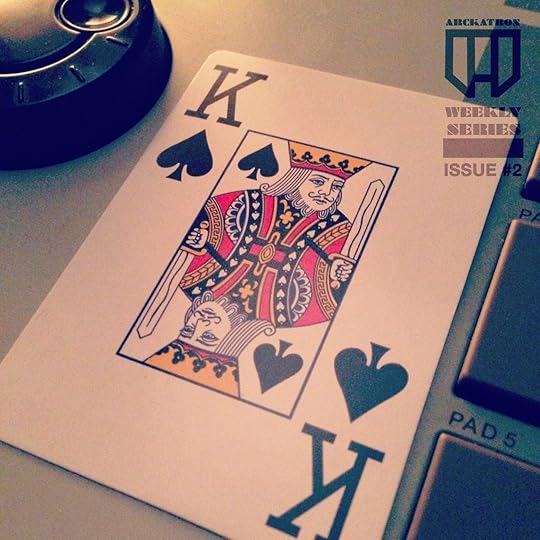
52pickUPbeetz by Arcka
The first Arckatron release of 2013 starts the year off with a banger, an ecstatic loop of split-second soul. It’s a rapid, short-duration cascade of horns and vocals and percussion that for one full minute loops the way a CD does when it’s caught on a hairline scratch — or how one’s memory does, when it’s distracted by the need to identify something familiar yet of tantalizingly uncertain origin. Such is often Arckatron’s modus operandi, as like many crate diggers he searches for less appreciated bits of antiquated recordings; unlike most of his peers, though, he seeks the abstractions implicit in the populist source material. In this case — track title:
“ks: Oddknox(ious)” — he’s made pure blipvert r&b. Around the one-minute mark there’s a brief drum figure that’s like the loop itself needs to catch its breath, and shortly thereafter it expands into a fanfold of longer but still delectably trunctated snippets.
Track originally posted for free download at arckatron.us.
January 4, 2013
Midwinter Blues
Colab‘s “Midwinter” is posted as a work-in-progress teaser from a forthcoming album, Fat Tuesday. Judging by that title, he has a little over a month to go. The track is a solid little piece, a mix of minimal-techno rhythmic play and industrial mecha-vocalization. The percussion is pointillist and vibrant, if icily so. The pings ricochet in slow motion and bound about in patterns that are less succinct than they might at first seem. The vocal, similarly, is less welcoming than is initially suggested; it remains just out of the reach of comprehensibility. As “Midwinter” progresses, an occasional piano figure nudges the track toward downtempo chaos, at time sounding like something else entirely is leaking in from a neighboring studio. It’s one more element of artfully implemented misdirection.
Track originally posted for free download at soundcloud.com/colab. More from Colab, aka Mikael Hansson of Toronto, Canada, at twitter.com/colab_toronto and at his ccmixter.org page.
January 3, 2013
Disquiet Junto Project 0053: Ice for 2013

Each Thursday at the Disquiet Junto group on Soundcloud.com a new compositional challenge is set before the group’s members, who then have just over four days to upload a track in response to the assignment. Membership in the Junto is open: just join and participate.
This assignment was made in the early evening, California time, on Thursday, January 3, 2013, with 11:59pm on the following Monday, January 7, as the deadline. Below are translations into four languages in addition to the original English: Croatian, Japanese, Polish, and Turkish, courtesy respectively of Darko Macan, Naoyuki Sasanami, Grzegorz Bojanek, and M. Emre Meydan.
These are the instructions that went out to the group’s email list (at tinyletter.com/disquiet-junto).
Disquiet Junto Project 0053: Ice for 2013
Happy new year! This week’s project is as follows:
Please record the sound of an ice cube rattling in a glass, and make something of it.
Background: Longtime participants in, and observers of, the Disquiet Junto series will recognize this single sentence as the very first Disquiet Junto project, the same one that launched the series on the first Thursday of 2012. Revisiting it a year later provides a fitting way to begin the new year. A weekly project series can come to overemphasize novelty, and it’s helpful to revisit old projects as much as it is to engage with new ones. Also, by its very nature, the Disquiet Junto suggests itself as a fast pace: a four-day production window, a weekly habit. It’s beneficial to step back and see things from a longer perspective.
Deadline: Monday, January 7, 2013, at 11:59pm wherever you are.
Length: Your finished work should be between 2 and 4 minutes in length.
Information: Please when posting your track on SoundCloud, include a description of your process in planning, composing, and recording it. This description is an essential element of the communicative process inherent in the Disquiet Junto.
Title/Tag: When adding your track to the Disquiet Junto group on Soundcloud.com, please include the term “disquiet0053-ice2013” in the title of your track, and as a tag for your track.
Download: It is preferable that your track is set as downloadable, and that it allows for attributed remixing (i.e., a Creative Commons license permitting non-commercial sharing with attribution).
Linking: When posting the track, be sure to include this information:
More on this 53rd Disquiet Junto project at:
http://disquiet.com/2013/01/03/disqui...
More details on the Disquiet Junto at:
http://soundcloud.com/groups/disquiet...
. . .
Project in Croatian:
Disquiet Junto Projekt 0053: S ledom u 2013.
Sretna Nova! Ovotjedni projekt glasi:
Snimite, molim, zvuk kockice leda kako zvecka u čaši te zatim načinite nešto od toga.
Pozadina: Stari sudionici, ili promatrači, Disquiet Junto serije prepoznat će u gornjoj rečenici prvi prvcati Disquiet Junto projekt, onaj s kojim je serija otpočela na prvi četvrtak u 2012. Vraćajući mu se godinu dana poslije dobijamo prikladan početak Nove godine. S obzirom da tjedna serija umije prevelik naglasak staviti na novo, podjednako je korisno podsjetiti se starih projekata koliko i upustiti se u nove. Usto, samom svojom prirodom Disquiet Junto je brzopotezan: četiri dana vremena za nastanak, tjedna navika. Blagotvorno se odmaknuti i sagledati stvari iz dalje perspektive.
Rok: Ponedjeljak, 7. siječnja, minutu do ponoći po lokalnom vremenu.
Trajanje: Neka vam snimci traju između 2 i 4 minute.
Informacije: Kad stavljate svoj snimak na SoundCloud, molim vas dodajte i opis procesa planiranja, komponiranja i snimanja. Taj opis je ključan element komunikacijskog procesa koji je u srži Disquiet Junta.
Naslov/Tag: Kad stavljate svoj snimak na Disquiet Junto grupu na Soundcloud.com, molim vas da uključite “disquiet0053-ice2013″ u naslov snimka te u njegov tag.
Downloadiranje: Draže mi je ako omogućite download svoga snimka te ako je omogućen remiks uz citiranje izvornika (n.pr. licenca Creative Commonsa koja dopušta nekomercijalno dijeljenje uz navođenje izvornika).
Linkanje: Kad stavljate snimak, molim vas da dodate sljedeću obavijest:
Više o 53. Disquiet Junto projektu na:
http://disquiet.com/2013/01/03/disqui...
More details on the Disquiet Junto at/Više o Disquiet Juntu na:
http://soundcloud.com/groups/disquiet...
. . .
Project in Japanese:
Disquiet Junto Project 0053: 2013年の氷プロジェクト
ハッピー・ニュー・イヤー!今週のお題は以下です。
グラスの中で氷をガラガラ鳴らした音を録音して何か作ってください。
背景:長い間このプロジェクトに参加している人や立ち会っている人であれば、このお題はDisquiet Juntoプロジェクトのごく初期のものだと知っていると思います。2012年の最初の木曜日に出されたお題を、2013年のはじまりにふさわしいお題としてもう一度やってみましょう。週替わりのシリーズは目新しいものに偏ってしまいます。新しいものをこなしていくのと同じくらい古いものを再びやってみることは無駄ではないはず。4日の製作期間枠や週替わりのプロジェクトという性質上、Disquiet Juntoは速いペースですが、一歩下がって長い視点から物事を見ることもいいでしょう。
〆切:1月7日月曜日11:59pm あなたがどこに住んでいるかかわらず
長さ:2-4分の長さにしてください
情報:作品をサウンドクラウドのグループに投稿する際には、あなたの採用した構想、作曲、録音の過程についての説明をつけてください。この記述がこのグループの本来の目的であるコミュニケーションに大事なものとなります
タイトル/タグ:Disquiet Juntoグループに作品を投稿する際には“disquiet0053-ice2013” という言葉をタイトルとタグに付けてください。
ダウンロード:ダウンロード可能、クリエイティヴ・コモンズ・ライセンスのもとにリミックスを許可することが望ましいです(例えば非営利、継承。cf. http://creativecommons.jp/licenses/)
リンク:投稿する際には以下の情報を追加してください
More on this 53rd Disquiet Junto project at:
http://disquiet.com/2013/01/03/disqui...
More details on the Disquiet Junto at:
http://soundcloud.com/groups/disquiet...
. . .
Project in Polish:
Disquiet Junto Project 0053: “Na lodzie” w 2013
Szczęścliwego Nowego Roku! Projekt na kolejny tydzień:
Proszę nagrać dźwięk kostek lodu grzechoczących w szklance i zrobić utwór z tego nagrania.
Historia: Ci, którzy są z nami już długo, a także obserwatorzy serii Disquiet Junto od razu rozpoznają to pojedyncze zdanie, które stało się podstawą pierwszego projektu Disquiet Junto – to samo, dzięki któremu seria ruszyła w pierwszy czwartek 2012 roku. Powrót do tematu rok później wydaje się być stosownym sposobem aby wejść w nowy rok. Cotygodniowa seria projektów może nie być już niczym nowym i stąd dobrym pomysłem może być ponowne starcie się ze starymi projektami, tak jak i szczere zaangażowanie w te zupełnie nowe. Także w naturze projektów Disquiet Junto leży szybkość pracy: czterodniowe “okno produkcyjne” to taki cotygodniowy zwyczaj. Korzystnym może być może być wykonanie kroku wstecz i spojrzenie na pewne sprawy z dłuższej perspektywy.
Deadline: Poniedziałek, 7 stycznia 2013, do godziny 23:59, gdziekolwiek mieszkacie
Długość: Ukończony utwór powinien trwać mieć długość od 2 do 4 minut.
Informacja: Proszę podać opis procesu twórczego, czyli planowania, komponowania i nagrywania. Opis ten jest podstawowym i nieodłącznym elementem projektów Disquiet Junto.
Tytuł/Tag: Przy dodawaniu utworu do grupy Disquiet Junto, proszę dodać informację “disquiet0053-ice2013” w tytule utworu i także na liście tagów.
Download: Byłoby dobrze, gdyby utwór można było pobrać, tak by można było wykonać remiksy (dlatego proszę o ustawienie licencji Creative Commons, które pozwalają na wykonaywanie prac pochodnych)
Linki: Po załadowniu, proszę o załączenie następującej informacji pod “chmurą”:
More on this 51st Disquiet Junto project at:
http://disquiet.com/2013/01/03/disqui...
More details on the Disquiet Junto at:
http://soundcloud.com/groups/disquiet...
. . .
Project in Turkish:
Disquiet Junto Projesi 0053: Ice for 2013 (2013 için buz)
Lütfen bir buz kübünün bardakta çıkardığı sesi kaydedip bununla bir parça yapın.
Geriplan: Disquiet Junto’nun uzun süreli katılımcıları ve takipçileri bu cümlenin 2012′nin ilk perşembe günü başlayan ilk Disquiet Junto projesine ait olduğunu farkedecekler. Aynı projeyi bir yıl sonra tekrarlamak, yeni yıla başlamanın uygun bir yolu olacak. Haftalık bir projeler dizisi, orijinallik kavramını gereğinden fazla vurgulayabilir, ve yeni projeler yapmak kadar eski projeleri de tekrarlamak faydalı olur. Ayrıca doğası gereği Disquiet Junto hızlı bir tempoyu gerektiriyor: 4 günlük bir üretim aralığı, haftalık bir alışkanlık. Geri adım atıp şeyleri uzak bir bakış açısından görmek yararlı olur.
Son Teslim Tarihi: 7 Ocak 2013 Pazartesi, 23:59 (bulunduğunuz ülkenin saatine göre)
Uzunluk: Çalışmanızın uzunluğu 2 ila 4 dakika arasında olmalı.
Bilgi: Yaptığınız parçayı paylaşırken, lütfen bu parçanın planlama, besteleme ve kayıt süreciyle ilgili bilgi de verin. Bu açıklama, Disquiet Junto’ya içkin iletişim sürecinin önemli bir parçasıdır.
İsim/Etiket: Parçanızı Soundcloud.com’daki Disquiet Junto grubuna eklerken, lütfen “disquiet0053-ice2013″ kelimesini hem parçanın isminde, hem de etiket (tag) olarak kullanın.
Download: Parçanızın indirilebilir olması ve “atfedilmiş (attributed) remix”e izin vermesi tercih edilir (orijinal sahibine atıf yapılarak ticari olmayan şekilde paylaşmaya izin veren bir Creative Commons lisansı gibi).
Linkler: Yaptığınız parçayı paylaşırken, şu satırları eklemeyi unutmayın:
Disquiet Junto projesi hakkında daha fazlası için:
http://disquiet.com/2013/01/03/disqui...
Disquiet Junto hakkında daha fazla bilgi için:
http://soundcloud.com/groups/disquiet...
Photo by Steven A. Johnson (flickr.com), via Creative Commons license.
January 2, 2013
… A Form of Change Repetition Is …
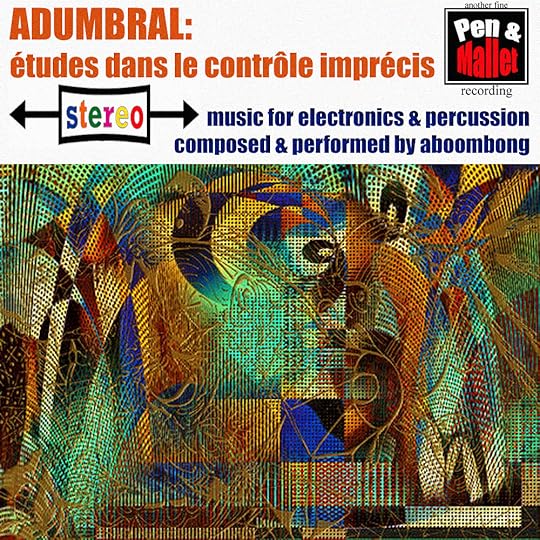
“K1″ is tagged as “minimalist” by its composer and performer, the Seattle-based musician Aboombong, and that it is — though more in a literal than a genre sense of the term. “K1″ is nearly four minutes long, during which a gurling riff of digital effluvia serves as a fond reminder that repetition is a form of change. As the riff moves along, its fragmentary subparts become familiar if not entirely recognizable, the frog-like rising burble that is its core, the downbeat bass note that suggests use in big-eared lounges, the bit of stereo play between speakers (or, better recommended, headphones) that especially delights the ears. Only for the final minute does the track diverge significantly, into a lightly flanging, quiet roar of drone, like a church organ heard from a great distance, obscured by some computer-enabled curtain.
Track originally posted for free download at soundcloud.com/aboombong. The song is the first of seven tracks on the new album
Adumbral: Études Dans le Contrôle Imprécis.
January 1, 2013
Synth Pop Turned Inside Out (MP3)
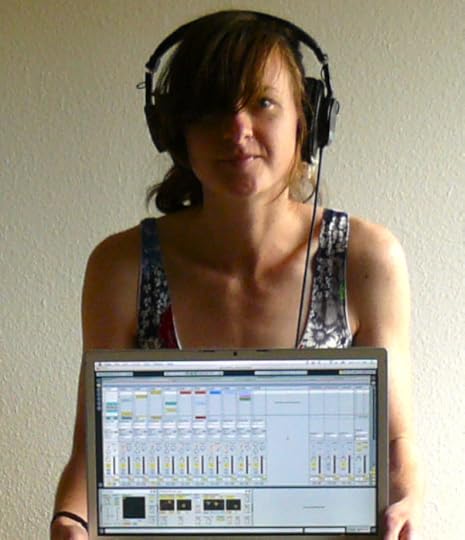
From within an opening mass of cloudy digital fragments comes a nimble if martial beat. It’s adorned, in time, with squiggly computer noise and a humorously sublimated vocal. The track is titled “Y’all” and it’s by Katie Gately, who’s based in Los Angeles and whose work here comes across like synth pop turned inside out. There are words caught in endless echo-repeats, phrases uttered and forgotten, raw syllables left to their own devices. The voice, which is to say the voice’s comprehensibility, slowly decays over the course of “Y’all,” and it ends up sounding like HAL 9000′s little sister crashing hard after a multi-day bender. What makes the track so great is how it seems like pop music even though it’s almost devoid of a proper song structure (there is something akin to a chorus, but it only occurs twice, and the second time it falls apart quickly). Even better is how the vocal line’s disintegration is treated as part of the music’s overall compositional development, how the words — or lack thereof, as it progresses — function as rhythm, melody, instrument, sound.
Track originally posted for free download at soundcloud.com/fionamoocow. The above photo is from Gately’s bio as part of the team behind a video game called The Moonlighters.
December 31, 2012
With a Blip
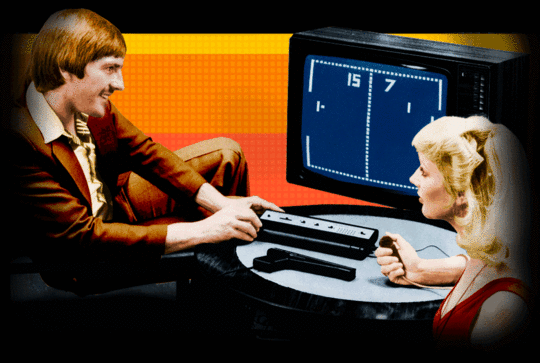
The year ends with not a bang or a whimper, but a blip. There are four blips, in fact: two pairs of the same tone, two low, two high, and they alternate to suggest a seesaw effect. There’s a gap between the pairs and this lends the decidedly electronic affair something that nonetheless might be suggestive of swing. The blips are at relative ease, their pacing slow, even if the overall recording is just 15 seconds in length. They’re best experienced as a loop, which adds a third beep: the seam that marks the slight incongruity between repetitions. And then there’s the light noise of foundation that permeates the space in which their transit takes place, sound that seems to be as if the blips themselves are heard coming into view and just as efficiently exiting it, the sonic equivalent of headlights and vapor trails. The recording is the latest in the innovative GIFBites series, in which each recorded MP3 is intended as the score to a pre-existing GIF image, in this case the nostalgic Pong image shown above.
Track originally posted at for free download at soundcloud.com/gifbites. There’s a bit more about the project at its homepage, gifbites.com.



